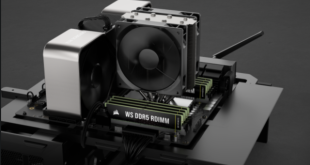Some people swear that memory is crucial to performance, while others think it's the ‘Emperor’s New Clothes' of upgrades. How much memory do you need, what speed should it run at and is it worth upgrading at all?
Technologies
Actual memory comes in tiny chips. These chips are mounted in groups on modules or sticks.
All system memory is double data rate (DDR) and it comes in 2 distinct flavours, DDR2 and DDR3.
The speed quoted gives you some idea of the transfer rate, with DDR2 starting around 800MHz and DDR3 reaching as high as 2400MHz.
How fast memory can react to instructions is called latency. It’s rated with a ‘CAS’ number. CAS 9 is slower than CAS6.
Latency is not as important to performance as how many channels the PC has to access that memory.
Most PCs use memory ‘2 sticks at a time’. This is called a dual-channel set-up and it is normal for Core i3, Core i5 and the AMD Phenom/Athlon processors. Intel’s Core i7 range benefits from memory installed ‘3 sticks at a time’. Triple channel memory systems are very fast.
Memory often comes with a speed rating, given as a ‘PC’ number, from PC6400 (800MHz DDR2), through to PC 19200 (2400MHz DDR3). This shows the bit rate. 8 bits make a byte of data and all 8 ‘wires’ can fire simultaneously at 2.4 million times a second, giving us a theoretical limit of 19.2Gb/sec.
Brands
The biggest brands have a reputation for quality and for delivering new memory technologies to market quickly, they include A-Data, Corsair, Crucial, G.Skil, Geil, Kingston and OCZ. These companies have created their brand/reputation by purchasing memory chips from chip manufacturers. Those manufacturers also sell memory modules and the biggest are Samsung, Hynex and Nanya, who – between them – make most of the world’s system memory.
How much memory?
Older 32-bit versions of Windows struggles to use more than about 3GB of memory. When benchmarking performance on 64-bit systems, it’s hard to show an improvement by moving from 4GB to 8GB on dual-channel systems and from 6GB to 9GB with Core i7 systems.
KitGuru thinks 4GB of DDR2 running at 1066MHz (PC8500) from a famous brand manufacturer is fine for dual channel systems. With Core i7 systems, you need to choose 1333MHz (PC10666) for a standard system and 1600MHz (PC12800) for an overclocking machine. If you already have 4-6GB of memory, then (pound for pound) it's probably one of the worst upgrade choices for your money.
Buy links…
Dabs
Overclockers
YOYOTech
 KitGuru KitGuru.net – Tech News | Hardware News | Hardware Reviews | IOS | Mobile | Gaming | Graphics Cards
KitGuru KitGuru.net – Tech News | Hardware News | Hardware Reviews | IOS | Mobile | Gaming | Graphics Cards


